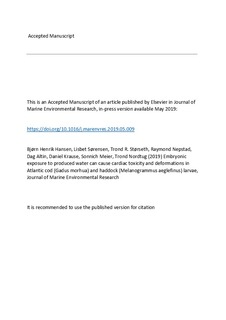| dc.description.abstract | Regular discharges of produced water from the oil and gas industry represents the largest direct discharge of effluent into the marine environment worldwide. Organic compound classes typically reported in produced water include saturated hydrocarbons, monoaromatic and polyaromatic hydrocarbons (MAHs, PAHs) as well as oxygenated compounds, such as phenols, acids and ketones. This forms a cocktail of known and suspect toxicants, but limited knowledge is yet available on the sub-lethal toxicity of produced water to cold-water marine fish species. In the present work, we conducted a 4-day exposure of embryos of Atlantic cod (Gadus morhua) and haddock (Melanogrammus aeglefinus) to produced water extracts equivalent to 1:50, 1:500 and 1:5000 times dilutions of raw effluent. No significant reduction in survival or hatching success was observed, however, for cod, hatching was initiated earlier for exposed embryos in a concentration-dependent manner. During recovery, significantly reduced embryonic heart rate was observed for both species. After hatch, larvae subjected to embryonic exposure to produced water extracts were smaller, and displayed signs of cardiotoxicity, jaw and craniofacial deformations. In order to improve risk assessment and regulation of produced water discharges, it is important to identify which produced water components contribute to these effects. | |
